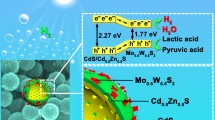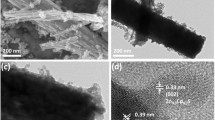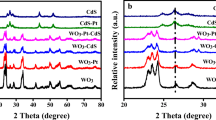Abstract
Artificial Z-scheme photocatalytic systems have received considerable attention in recent years because they can achieve wide light-absorption, high charge-separation efficiency, and strong redox ability simultaneously. Nevertheless, it is still challenging to exploit low-cost and stable Z-scheme photocatalysts with highly-efficient H2 evolution from solar water-splitting so far. Herein, we report a novel all-solid-state Z-scheme photocatalyst Cd1−xZnxS@WO3−x consisting of Cd1−xZnxS nanorods coated with oxygen-deficient WO3−x amorphous layers. The Cd1−xZnxS@WO3−x exhibits an outstanding H2 evolution reaction (HER) activity as compared with Pt-loaded Cd1−xZnxS and most \({\bf{W}}{{\bf{O}}_{{3^{-}}}}\) and CdS-based photocatalysts, due to the generation of stronger reducing electrons through the appropriate Zn-do** in Cd1−xZnxS and the enhanced charge transfer by introducing oxygen vacancies (W5+/OVs) into the ultrathin WO3−x amorphous coatings. The optimal HER rate of Cd1−xZnxS@WO3−x is determined to be 21.68 mmol h−1 g−1, which is further raised up to 28.25 mmol h−1 g−1 (about 12 times more than that of Pt/Cd1−xZnxS) when Cd1−xZnxS@WO3−x is hybridized by CoOx and NiOx dual cocatalysts (Cd1−xZnxS@WO3−x/CoOx/NiOx) through in-situ photo-deposition. Moreover, the corresponding apparent quantum yield (AQY) at 420 nm is significantly increased from 34.6% for Cd1−xZnxS@WO3−x to 60.8% for Cd1−xZnxS@WO3−x/CoOx/NiOx. In addition, both Cd1−xZn−-S@WO3−x and Cd1−xZnxS@WO3−x/CoOx/NiOx demonstrate good stability towards HER. The results displayed in this work will inspire the rational design and synthesis of high-performance nanostructures for photocatalytic applications.
摘要
人工Z-机制光催化剂因其同时具有光吸收范围宽、电荷分离效率高以及载流子氧化还原能力**等优势受到了研究者们的广泛关注. 然而, 设计和制备能够利用太阳能进行高效光解水产氢的低成本、高稳定性非贵金属Z-机制光催化剂仍具有挑战性. 本文报道了一种新颖的全固态Z-机制光催化剂Cd1−xZnxS@WO3−x, 该催化剂纳米结构是由氧缺陷WO3−x非晶层包覆Cd1−xZnxS纳米棒组成. 研究结果表明, 由于适量的Zn掺杂使得Cd1−xZnxS具有更**的产生还原性电子能力, 同时, WO3−x超薄非晶层中引入的氧空位(W5 +/OVs)有效地促进了电荷的分离, 使得该Z-机制Cd1−x-ZnxS@WO3−x光催化材料具有优异的光催化产氢反应(HER)活性, 且显著高于贵金属Pt负载的Cd1−xZnxS纳米棒(Pt/Cd1−xZnxS)及绝大多数WO3和CdS基光催化剂. 优化后的Cd1−xZnxS@WO3−x复合光催化剂的HER速率可达21.68 mmol h−1 g−1. 进一步通过原位光沉积负载CoOx和NiOx双共催化剂, Cd1−xZnxS@WO3−x/CoOx/NiOx复合材料的活性高达28.25 mmol h−1 g−1, 约为Pt/Cd1−xZnxS的12倍. 计算结果表明, Cd1−xZnxS@WO3−x在420 nm激发光下的HER表观量子产率(AQY)为34.6%, 而负载CoOx和NiOx双共催化剂后的Cd1−x-ZnxS@WO3−x/CoOx/NiOx的AQY提高到了60.8%. 此外, Cd1−xZnxS@WO3−x和Cd1−xZnxS@WO3−x/CoOx/NiOx均表现出了良好的长时间HER稳定性. 该工作将为理性设计和制备高效光解水产氢催化剂提供新视角.
Similar content being viewed by others
Referenses
**ao M, Wang Z, Lyu M, et al. Hollow nanostructures for photocatalysis: advantages and challenges. Adv Mater, 2018, 315: 1801369
Zhao K, Zhao S, Gao C, et al. Metallic cobalt-carbon composite as recyclable and robust magnetic photocatalyst for efficient CO2 reduction. Small, 2018, 14: 1800762
Wang J, Cui Y, Wang D. Design of hollow nanostructures for energy storage, conversion and production. Adv Mater, 2018, 20: 1801993
Wang L, Wan J, Zhao Y, et al. Hollow multi-shelled structures of Co3O4 dodecahedron with unique crystal orientation for enhanced photocatalytic CO2 reduction. J Am Chem Soc, 2019, 141: 2238–2241
Wei Y, Wang J, Yu R, et al. Constructing SrTiO3-TiO2 heterogeneous hollow multi-shelled structures for enhanced solar water splitting. Angew Chem Int Ed, 2019, 58: 1422–1426
Huang ZF, Song J, Li K, et al. Hollow cobalt-based bimetallic sulfide polyhedra for efficient all-pH-value electrochemical and photocatalytic hydrogen evolution. J Am Chem Soc, 2016, 138: 1359–1365
Yuan YP, Ruan LW, Barber J, et al. Hetero-nanostructured suspended photocatalysts for solar-to-fuel conversion. Energy Environ Sci, 2014, 7: 3934–3951
Han T, Chen Y, Tian G, et al. Hydrogenated TiO2/SrTiO3 porous microspheres with tunable band structure for solar-light photocatalytic H2 and O2 evolution. Sci China Mater, 2016, 59: 1003–1016
Zhou P, Yu J, Jaroniec M. All-solid-state Z-scheme photocatalytic systems. Adv Mater, 2014, 26: 4920–4935
**ang Q, Yu J, Jaroniec M. Graphene-based semiconductor photocatalysts. Chem Soc Rev, 2012, 41: 782–796
Rahman MZ, Zhang J, Tang Y, et al. Graphene oxide coupled carbon nitride homo-heterojunction photocatalyst for enhanced hydrogen production. Mater Chem Front, 2017, 1: 562–571
Lingampalli SR, Rao CNR. Remarkable improvement in visible-light induced hydrogen generation by ZnO/Pt/Cd1−yZnyS heterostructures through substitution of N and F in ZnO. J Mater Chem A, 2014, 2: 7702–7705
Lingampalli SR, Gautam UK, Rao CNR. Highly efficient photocatalytic hydrogen generation by solution-processed ZnO/Pt/CdS, ZnO/Pt/Cd1−xZnxS and ZnO/Pt/CdS1−xSex hybrid nanostructures. Energy Environ Sci, 2013, 6: 3589–3594
Du H, Liu YN, Shen CC, et al. Nanoheterostructured photocatalysts for improving photocatalytic hydrogen production. Chin J Catal, 2017, 38: 1295–1306
Zhu M, Sun Z, Fujitsuka M, et al. Z-scheme photocatalytic water splitting on a 2D heterostructure of black phosphorus/bismuth vanadate using visible light. Angew Chem Int Ed, 2018, 57: 2160–2164
Zhang Z, Huang J, Fang Y, et al. A nonmetal plasmonic Z-scheme photocatalyst with UV- to NIR-driven photocatalytic protons reduction. Adv Mater, 2017, 29: 1606688
Cheng L, **ang Q, Liao Y, et al. CdS-based photocatalysts. Energy Environ Sci, 2018, 11: 1362–1391
Chen J, Wu XJ, Yin L, et al. One-pot synthesis of CdS nanocrystals hybridized with single-layer transition-metal dichalcogenide nanosheets for efficient photocatalytic hydrogen evolution. Angew Chem Int Ed, 2015, 54: 1210–1214
Du H, **e X, Zhu Q, et al. Metallic MoO2 cocatalyst significantly enhances visible-light photocatalytic hydrogen production over MoO2/Zn0.5Cd0.5S heterojunction. Nanoscale, 2015, 7: 5752–5759
Huang ZF, Song J, Pan L, et al. Tungsten oxides for photocatalysis, electrochemistry, and phototherapy. Adv Mater, 2015, 27: 5309–5327
Li H, Zhao F, Zhang J, et al. A g-C3N4/WO3 photoanode with exceptional ability for photoelectrochemical water splitting. Mater Chem Front, 2017, 1: 338–342
Yang C, Chen JF, Zeng X, et al. Enhanced photochemical performance of hexagonal WO3 by metal-assisted S-O coupling for solar-driven water splitting. Sci China Mater, 2018, 61: 91–100
Yousaf AB, Imran M, Zaidi SJ, et al. Highly efficient photocatalytic Z-scheme hydrogen production over oxygen-deficient WO3−x nanorods supported Zn0.3Cd0.7S heterostructure. Sci Rep, 2017, 7: 6574
** J, Yu J, Guo D, et al. A hierarchical Z-scheme CdS-WO3 photocatalyst with enhanced CO2 reduction activity. Small, 2015, 11: 5262–5271
Zhang LJ, Li S, Liu BK, et al. Highly efficient CdS/WO3 photocatalysts: Z-scheme photocatalytic mechanism for their enhanced photocatalytic H2 evolution under visible light. ACS Catal, 2014, 4: 3724–3729
Liu Z, Wu J, Zhang J. Quantum dots and plasmonic Ag decorated WO3 nanorod photoanodes with enhanced photoelectrochemical performances. Int J Hydrogen Energy, 2016, 41: 20529–20535
Yin XL, Liu J, Jiang WJ, et al. Urchin-like Au@CdS/WO3 micro/nano heterostructure as a visible-light driven photocatalyst for efficient hydrogen generation. Chem Commun, 2015, 51: 13842–13845
Tian B, Yang B, Li J, et al. Water splitting by CdS/Pt/WO3-CeOx photocatalysts with assisting of artificial blood perfluorodecalin. J Catal, 2017, 350: 189–196
Roy A, Lingampalli SR, Nassar IM, et al. Effectiveness of NiO in replacing Pt in the photochemical generation of hydrogen by (TiO2)1−x(NiO)x/Cd0.8Zn0.2S heterostructures. Solid State Commun, 2016, 243: 1–6
Du H, Liang K, Yuan CZ, et al. Bare Cd1−xZnxS ZB/WZ heterophase nanojunctions for visible light photocatalytic hydrogen production with high efficiency. ACS Appl Mater Interfaces, 2016, 8: 24550–24558
**ao F, Zhou W, Sun B, et al. Engineering oxygen vacancy on rutile TiO2 for efficient electron-hole separation and high solar-driven photocatalytic hydrogen evolution. Sci China Mater, 2018, 61: 822–830
Li Q, Meng H, Zhou P, et al. Zn1−xCdxS solid solutions with controlled bandgap and enhanced visible-light photocatalytic H2-production activity. ACS Catal, 2013, 3: 882–889
Li R, Zhang F, Wang D, et al. Spatial separation of photogenerated electrons and holes among {010} and {110} crystal facets of BiVO4. Nat Commun, 2013, 4: 1432
Lin H, Sun B, Wang H, et al. Unique 1D Cd1−xZnxS@OMoS2/NiOx nanohybrids: Highly efficient visible-light-driven photocatalytic hydrogen evolution via integrated structural regulation. Small, 2019, 15: 1804115
Zhang X, Zhao Z, Zhang W, et al. Surface defects enhanced visible light photocatalytic H2 production for Zn-Cd-S solid solution. Small, 2016, 12: 793–801
Xu X, Hu L, Gao N, et al. Controlled growth from ZnS nanoparticles to ZnS-CdS nanoparticle hybrids with enhanced photoactivity. Adv Funct Mater, 2015, 25: 445–454
Su Y, Zhang Z, Liu H, et al. Cd0.2Zn0.8S@UiO-66-NH2 nanocomposites as efficient and stable visible-light-driven photocatalyst for H2 evolution and CO2 reduction. Appl Catal B-Environ, 2017, 200: 448–457
Liu B, Yao H, Song W, et al. Ligand-free noble metal nanocluster catalysts on carbon supports via “soft” nitriding. J Am Chem Soc, 2016, 138: 4718–4721
Wang H, Naghadeh SB, Li C, et al. Enhanced photoelectrochemical and photocatalytic activities of CdS nanowires by surface modification with MoS2 nanosheets. Sci China Mater, 2018, 61: 839–850
Chao Y, Zhou P, Li N, et al. Ultrathin visible-light-driven Mo incorporating In2O3-ZnIn2Se4 Z-scheme nanosheet photocatalysts. Adv Mater, 2019, 31: 1807226
Tian FY, Hou D, Tang F, et al. Novel Zn0.8Cd0.2S@g-C3N4 core-shell heterojunctions with a twin structure for enhanced visible-light-driven photocatalytic hydrogen generation. J Mater Chem A, 2018, 6: 17086–17094
Jiang B, Tian C, Pan Q, et al. Enhanced photocatalytic activity and electron transfer mechanisms of graphene/TiO2 with exposed {001} facets. J Phys Chem C, 2011, 115: 23718–23725
Zhao ZG, Liu ZF, Miyauchi M. Tailored remote photochromic coloration of in situ synthesized CdS quantum dot loaded WO3 films. Adv Funct Mater, 2010, 20: 4162–4167
Gopannagari M, Kumar DP, Reddy DA, et al. In situ preparation of few-layered WS2 nanosheets and exfoliation into bilayers on CdS nanorods for ultrafast charge carrier migrations toward enhanced photocatalytic hydrogen production. J Catal, 2017, 351: 153–160
Song J, Huang ZF, Pan L, et al. Oxygen-deficient tungsten oxide as versatile and efficient hydrogenation catalyst. ACS Catal, 2015, 5: 6594–6599
Chen TY, Chang YH, Hsu CL, et al. Comparative study on MoS2 and WS2 for electrocatalytic water splitting. Int J Hydrogen Energy, 2013, 38: 12302–12309
Li Y, Zhao KQ, Feng C, et al. Ethyleneglycol tungsten complexes of calix[6 and 8]arenes: synthesis, characterization and ROP of ε-caprolactone. Dalton Trans, 2014, 43: 13612–13619
Zhou P, Xu Q, Li H, et al. Fabrication of two-dimensional lateral heterostructures of WS2/WO3·H2O through selective oxidation of monolayer WS2. Angew Chem, 2015, 127: 15441–15445
Ratcliff EL, Meyer J, Steirer KX, et al. Evidence for near-surface NiOOH species in solution-processed NiOx selective interlayer materials: Impact on energetics and the performance of polymer bulk heterojunction photovoltaics. Chem Mater, 2011, 23: 4988–5000
Wang L, Tsang CS, Liu W, et al. Disordered layers on WO3 nanoparticles enable photochemical generation of hydrogen from water. J Mater Chem A, 2019, 7: 221–227
Fang Z, Jiao S, Wang B, et al. Synthesis of reduced cubic phase WO3−x nanosheet by direct reduction of H2WO4·H2O. Mater Today Energy, 2017, 6: 146–153
Mahler B, Hoepfner V, Liao K, et al. Colloidal synthesis of 1T-WS2 and 2H-WS2 nanosheets: Applications for photocatalytic hydrogen evolution. J Am Chem Soc, 2014, 136: 14121–14127
Liu Z, Li N, Su C, et al. Colloidal synthesis of 1T’ phase dominated WS2 towards endurable electrocatalysis. Nano Energy, 2018, 50: 176–181
Zhang H, Zhang P, Qiu M, et al. Ultrasmall MoOx clusters as a novel cocatalyst for photocatalytic hydrogen evolution. Adv Mater, 2018, 113: 1804883
Zhao Z, **ng Y, Li H, et al. Constructing CdS/Cd/doped TiO2 Z-scheme type visible light photocatalyst for H2 production. Sci China Mater, 2018, 61: 851–860
Chang K, Li M, Wang T, et al. Drastic layer-number-dependent activity enhancement in photocatalytic H2 evolution over nMoS2/CdS (n ≥ 1) under visible light. Adv Energy Mater, 2015, 5: 1402279
Zhuang TT, Liu Y, Sun M, et al. A unique ternary semiconductor-(semiconductor/metal) nano-architecture for efficient photocatalytic hydrogen evolution. Angew Chem Int Ed, 2015, 54: 11495–11500
Zong X, Yan HJ, Wu GP, et al. Enhancement of photocatalytic H2 evolution on CdS by loading MoS2 as cocatalyst under visible light irradiation. J Am Chem Soc, 2008, 130: 7176–7177
Prusty G, Guria AK, Mondal I, et al. Modulated binary-ternary dual semiconductor heterostructures. Angew Chem Int Ed, 2016, 55: 2705–2708
Yin XL, Li LL, Jiang WJ, et al. MoS2/CdS nanosheets-on-nanorod heterostructure for highly efficient photocatalytic H2 generation under visible light irradiation. ACS Appl Mater Interfaces, 2016, 8: 15258–15266
Simon T, Bouchonville N, Berr MJ, et al. Redox shuttle mechanism enhances photocatalytic H2 generation on Ni-decorated CdS nanorods. Nat Mater, 2014, 13: 1013–1018
Ruan Q, Luo W, **e J, et al. A nanojunction polymer photoelectrode for efficient charge transport and separation. Angew Chem Int Ed, 2017, 56: 8221–8225
Kim ES, Nishimura N, Magesh G, et al. Fabrication of CaFe2O4/TaON heterojunction photoanode for photoelectrochemical water oxidation. J Am Chem Soc, 2013, 135: 5375–5383
Chang X, Wang T, Zhang P, et al. Enhanced surface reaction kinetics and charge separation of p-n heterojunction Co3O4/BiVO4 photoanodes. J Am Chem Soc, 2015, 137: 8356–8359
Li K, Han M, Chen R, et al. Hexagonal@cubic CdS core@shell nanorod photocatalyst for highly active production of H2 with unprecedented stability. Adv Mater, 2016, 28: 8906–8911
Yang H, ** Z, Liu D, et al. Visible light harvesting and spatial charge separation over the creative Ni/CdS/Co3O4 photocatalyst. J Phys Chem C, 2018, 122: 10430–10441
Biesinger MC, Payne BP, Grosvenor AP, et al. Resolving surface chemical states in XPS analysis of first row transition metals, oxides and hydroxides: Cr, Mn, Fe, Co and Ni. Appl Surf Sci, 2011, 257: 2717–2730
Wang M, Hu Y, Han J, et al. TiO2/NiO hybrid shells: p-n junction photocatalysts with enhanced activity under visible light. J Mater Chem A, 2015, 3: 20727–20735
Tan BJ, Klabunde KJ, Sherwood PMA. XPS studies of solvated metal atom dispersed (SMAD) catalysts. Evidence for layered cobalt-manganese particles on alumina and silica. J Am Chem Soc, 1991, 113: 855–861
He J, Wang J, Chen Y, et al. A dye-sensitized Pt@UiO-66(Zr) metal-organic framework for visible-light photocatalytic hydrogen production. Chem Commun, 2014, 50: 7063–7066
Lin R, Wan J, **ong Y, et al. Quantitative study of charge carrier dynamics in well-defined WO3 nanowires and nanosheets: Insight into the crystal facet effect in photocatalysis. J Am Chem Soc, 2018, 140: 9078–9082
Pan J, Liu G, Lu GQM, et al. On the true photoreactivity order of {001}, {010}, and {101} facets of anatase TiO2 crystals. Angew Chem, 2011, 123: 2181–2185
Tian J, Hao P, Wei N, et al. 3D Bi2MoO6 nanosheet/TiO2 nanobelt heterostructure: Enhanced photocatalytic activities and photoelectochemistry performance. ACS Catal, 2015, 5: 4530–4536
Kröger M, Hamwi S, Meyer J, et al. Role of the deep-lying electronic states of MoO3 in the enhancement of hole-injection in organic thin films. Appl Phys Lett, 2009, 95: 123301
Liu G, Schulmeyer T, Brötz J, et al. Interface properties and band alignment of Cu2S/CdS thin film solar cells. Thin Solid Films, 2003, 431–432: 477–482
Wang H, Zhang L, Chen Z, et al. Semiconductor heterojunction photocatalysts: design, construction, and photocatalytic performances. Chem Soc Rev, 2014, 43: 5234–5244
Huang ZF, Song J, Wang X, et al. Switching charge transfer of C3N4/W18O49 from type-II to Z-scheme by interfacial band bending for highly efficient photocatalytic hydrogen evolution. Nano Energy, 2017, 40: 308–316
Chen X, Chen W, Gao H, et al. In situ photodeposition of NiOx on CdS for hydrogen production under visible light: enhanced activity by controlling solution environment. Appl Catal B-Environ, 2014, 152–153: 68–72
**n Y, Huang Y, Lin K, et al. Self-template synthesis of double-layered porous nanotubes with spatially separated photoredox surfaces for efficient photocatalytic hydrogen production. Sci Bull, 2018, 63: 601–608
Chen X, Chen W, Lin P, et al. In situ photodeposition of nickel oxides on CdS for highly efficient hydrogen production via visible-light-driven photocatalysis. Catal Commun, 2013, 36: 104–108
Wang J, **a Y, Zhao H, et al. Oxygen defects-mediated Z-scheme charge separation in g-C3N4/ZnO photocatalysts for enhanced visible-light degradation of 4-chlorophenol and hydrogen evolution. Appl Catal B-Environ, 2017, 206: 406–416
**ng X, Zhang M, Hou L, et al. Z-scheme BCN-TiO2 nanocomposites with oxygen vacancy for high efficiency visible light driven hydrogen production. Int J Hydrogen Energy, 2017, 42: 28434–28444
Guo HL, Du H, Jiang YF, et al. Artificial photosynthetic Z-scheme photocatalyst for hydrogen evolution with high quantum efficiency. J Phys Chem C, 2017, 121: 107–114
Jia X, Tahir M, Pan L, et al. Direct Z-scheme composite of CdS and oxygen-defected CdWO4: An efficient visible-light-driven photocatalyst for hydrogen evolution. Appl Catal B-Environ, 2016, 198: 154–161
**e YP, Yang Y, Wang G, et al. Oxygen vacancies promoted interfacial charge carrier transfer of CdS/ZnO heterostructure for photocatalytic hydrogen generation. J Colloid Interface Sci, 2017, 503: 198–204
Dong Z, Wu Y, Thirugnanam N, et al. Double Z-scheme ZnO/ ZnS/g-C3N4 ternary structure for efficient photocatalytic H2 production. Appl Surf Sci, 2018, 430: 293–300
Acknowledgements
This work was financially supported by the National Natural Science Foundation of China (51572136, 51772162, 21571112, 51802170 and 21801150), the Natural Science Foundation of Shandong Province (ZR2018BEM014, ZR2018LB008 and ZR2019MB001), Taishan Scholar Foundation of Shandong Province (H. W., ts201712047), the Special Fund Project to Guide Development of Local Science and Technology by Central Government (H.W.), and Taishan Scholar Program of Advantage and Characteristic Discipline Team of Eco Chemical Process and Technology.
Author information
Authors and Affiliations
Contributions
Lin H designed and engineered the experiments; Li Y, Ruan Q, Geng Y, Wang J, and Wang H performed the experiments, analyzed the data and wrote the paper with support from Yang Y and Wang L. All authors contributed to the general discussion.
Corresponding authors
Additional information
Conflict of interest
The authors declare no conflict of interest.
Supplementary information
Supporting data are available in the online version of the paper.
Yanyan Li is currently an associate professor in the College of Chemistry and Molecular Engineering, Qingdao University of Science and Technology. She received her PhD degree in material physics and chemistry from Fujian Institute of Research on the Structure of Matter, Chinese Academy of Sciences in 2015. Her current research mainly focuses on the design, synthesis and photocatalytic applications of semiconductor nanocrystals.
Haifeng Lin received his PhD degree from Fujian Institute of Research on the Structure of Matter, Chinese Academy of Sciences in 2014. Then, he worked as a postdoctoral scholar at Tsinghua University (2014–2017). In 2017, he joined Qingdao University of Science and Technology as an associate professor. His current research interest concentrates on the design and controlled synthesis of semiconducting nanohybrids and their applications in efficient solar-to-fuel conversion.
Lei Wang obtained his PhD degree in inorganic chemistry from Jilin University in 2006. He is now a professor in inorganic chemistry in the College of Chemistry and Molecular Engineering, Qingdao University of Science and Technology. The current research of his group focuses on the synthesis of nano-sized functional materials for applications in photocatalysis, electrocatalysis, and batteries.
Supplementary information
40843_2019_1179_MOESM1_ESM.pdf
Unique Cd1−xZnxS@WO3−x and Cd1−xZnxS@WO3−x/ CoOx/NiOx Z-scheme photocatalysts for efficient visible-light-induced H2 evolution
Rights and permissions
About this article
Cite this article
Li, Y., Ruan, Q., Lin, H. et al. Unique Cd1−xZnxS@WO3−x and Cd1−xZnxS@WO3−x/CoOx/NiOx Z-scheme photocatalysts for efficient visible-light-induced H2 evolution. Sci. China Mater. 63, 75–90 (2020). https://doi.org/10.1007/s40843-019-1179-4
Received:
Accepted:
Published:
Issue Date:
DOI: https://doi.org/10.1007/s40843-019-1179-4




